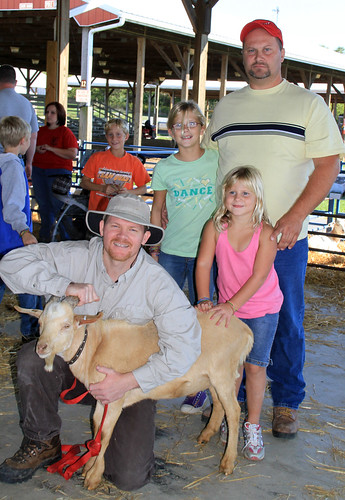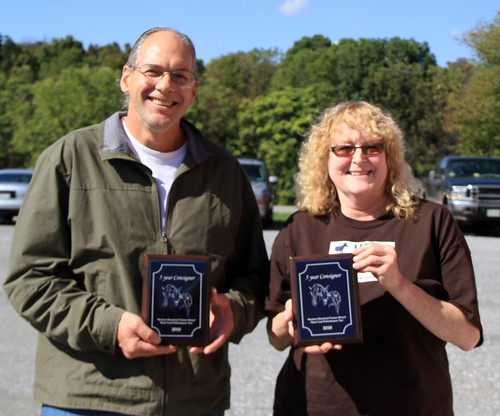The ten goat carcasses were a further reminder of how dry this year's test was. I'd never seen such lean carcasses. On the other hand, the carcasses looked really good and yielded the same as last year.
The 2010 test site did not receive any meaningful rainfall during the entire test period, from June 4 until September 23. The week after the test was over (and before the sale on October 2), the test site receive 4.77 inches of rainfall. I got drenched to the bone the day I loaded two goats for slaughter for the field day.
For the first four years of the test, rainfall averaged 15.4 inches, about 3 to 4 inches per month, though there were some dry months. In 2010, rainfall was only 5.11 inches. In addition, most of the downpours were short-lived and hard, doing little good for the pasture. Coupled with the record heat, this made for poor quality forage and stressful conditions for the goats.
While I don't ever want to see another year like this, this year's test showed what goats are truly capable of. They are amazing animals. The goats that came off the test healthy and vigorous proved their worth and genetic value. It amazed me they could gain anything off this year's paltry pasture.
Similarly aged bucks that are bigger and fleshier than the bucks from this year's test aren't better. They've just been fed more. Be sure to know the difference between environment and genetics. What do you think these bucks would look like (and weigh) if they spent 100 days in the 2010 Western Maryland Drought-Ravaged Meat Goat Performance Test?
Thursday, October 28, 2010
Tuesday, October 12, 2010
Goat test featured in Lancaster Farming
Lancaster Farming did a feature article on the recent Western Maryland Goat Field Day & Sale, which it billed as "an interactive day about meat goats from hoof to plate."
While youth participated in a skillathon and top bucks from the meat goat test went on the silent auction block, Dr. Paul Kuber, a research animal scientist from Ohio State University showed participants how to process a goat carcass and prepare dishes featuring chevon.
Kuber told producers they should eat their own product before marketing meat to consumers. He said that marketing goat meat and processing goats into cuts is all new territory. While some ethnic groups prefer their goat meat processed into chunks with no concern for different cuts, traditional markets may be the next step for the goat industry, according to Kuber.
Lancaster Farming is the leading Northeast and Mid-Atlantic farm newspaper. It has 56,000 paid subscribers in Pennsylvania and fifteen other states.
Source: "Field Day Puts Focus on Meat Goats," by Laurie Savage, Maryland correspondent, Lancaster Farming, October 9, 2010.
Page 1 of article
Page 2 of article
 |
| Dr. Paul Kuber |
Kuber told producers they should eat their own product before marketing meat to consumers. He said that marketing goat meat and processing goats into cuts is all new territory. While some ethnic groups prefer their goat meat processed into chunks with no concern for different cuts, traditional markets may be the next step for the goat industry, according to Kuber.
Lancaster Farming is the leading Northeast and Mid-Atlantic farm newspaper. It has 56,000 paid subscribers in Pennsylvania and fifteen other states.
Source: "Field Day Puts Focus on Meat Goats," by Laurie Savage, Maryland correspondent, Lancaster Farming, October 9, 2010.
Page 1 of article
Page 2 of article
Monday, October 11, 2010
2010 carcass evaluation
One of the goals of the Western Maryland Pasture-Based Meat Goat Performance Test is to evaluate and compare carcass characteristics of meat goats consuming a pasture-only diet. This year, ten bucks from ten different consignors were selected for harvest and deboning.
The bucks were transported from the test site on October 7 to LambCo LLC, where they were humanely harvested on the same day. LambCo, LLC is a USDA/custom abattoir in New Windsor, Maryland.
Carcass yields were similar to last year (25.3 percent average). Dressing percentages (hot carcass weights/live weights) were higher (48.1 percent average), but this was because the organs (heart, liver, and testicles) had been left in the carcasses.
If the organs had been removed (as is common) before carcass weights were determined, the percentages of fat, bone, and lean would be higher for this year's goats.
Warren and Liz Barnes from Summersville, Missouri, had the buck with the best carcass. Their 72-lb. Kiko buck (#16) had a lean meat yield of 30.9 percent, 5.3 percent above the group average. It had the biggest rib eye at 1.8 square inches. The group average was 1.0 square inches. Its dressing percentage was 52.9 percent.
The carcass evaluation was done by Jeff Semler, David Gordon, and Susan Schoenian.
Download 2010 carcass data in table format
Read full article about 2010 carcass evaluation
The bucks were transported from the test site on October 7 to LambCo LLC, where they were humanely harvested on the same day. LambCo, LLC is a USDA/custom abattoir in New Windsor, Maryland.
 |
| The ten carcasses from this year's evaluation. |
If the organs had been removed (as is common) before carcass weights were determined, the percentages of fat, bone, and lean would be higher for this year's goats.
Warren and Liz Barnes from Summersville, Missouri, had the buck with the best carcass. Their 72-lb. Kiko buck (#16) had a lean meat yield of 30.9 percent, 5.3 percent above the group average. It had the biggest rib eye at 1.8 square inches. The group average was 1.0 square inches. Its dressing percentage was 52.9 percent.
The carcass evaluation was done by Jeff Semler, David Gordon, and Susan Schoenian.
Download 2010 carcass data in table format
Read full article about 2010 carcass evaluation
Wednesday, October 6, 2010
Top buck brings $1400
The top-performing buck of the 2010 Western Maryland Pasture-Based Meat Goat Performance Test brought $1,400 at the recent sale on October 2. The buyer was Troy Probst from Lock Haven, Pennsylvania.
The Purebred Kiko buck was consigned by Craig Adams from Litchfield, Illinois. Craig had three bucks in the top 11. For this year's test, Craig had both the top-performing buck and the top consignment of bucks. Adams also had the top-performing buck and top consignment in the 2009 test.
Adams' #2 buck excelled in almost every category. Besides having the highest rate-of-gain (almost twice as much as the test average), the buck had the largest rib eye (according to ultrasound) of any buck in the test. Two other bucks had the same size rib eye, but these bucks were at least 20 lbs. heavier than the Adams' buck.
#2 never required deworming (or any other treatment) while on test. His FAMACHA© score was 1 every time it was evaluated. The #2 buck had an average fecal egg count of 243 eggs per gram. When you consider the difficult conditions in this year's test, the performance of the #2 buck is truly outstanding.
The purpose of the Western Maryland Pasture-Based Meat Goat Performance Test is to measure the post-weaning performance of bucklings managed in a pasture environment with no supplemental feed. While this year's extreme drought necessitated the feeding of hay, the goats often refused to eat the hay, instead relying on the drought-ravaged pastures.
The Purebred Kiko buck was consigned by Craig Adams from Litchfield, Illinois. Craig had three bucks in the top 11. For this year's test, Craig had both the top-performing buck and the top consignment of bucks. Adams also had the top-performing buck and top consignment in the 2009 test.
 |
| TOP-PERFORMING AND SELLING BUCK Troy Probst (L) - buyer Craig Adams (R, with his children) - consignor |
#2 never required deworming (or any other treatment) while on test. His FAMACHA© score was 1 every time it was evaluated. The #2 buck had an average fecal egg count of 243 eggs per gram. When you consider the difficult conditions in this year's test, the performance of the #2 buck is truly outstanding.
The purpose of the Western Maryland Pasture-Based Meat Goat Performance Test is to measure the post-weaning performance of bucklings managed in a pasture environment with no supplemental feed. While this year's extreme drought necessitated the feeding of hay, the goats often refused to eat the hay, instead relying on the drought-ravaged pastures.
Sunday, October 3, 2010
Five year consignors
At the 3rd Annual Western Maryland Goat Field Day & Sale, held October 2, two consignors were awarded plaques for having consigned bucks to the test during each of the first five years of the test (2006-2010).
Jeanne Dietz-Band (Many Rocks Farm) from Keedysville, Maryland, was awarded a plaque. Jeanne has consigned five bucks to each of the five performance tests. She had the top-performing buck in 2006.
Don Smith from Charlottesville, Virginia was also awarded a plaque. Don has consigned five bucks to each of the five performance tests. He had the top-performing buck in 2007.
The Western Maryland Pasture-Based Meat Goat Performance Test would not be possible without the support of consignors such as Jeanne and Don. Congratulations to both of them.
Jeanne Dietz-Band (Many Rocks Farm) from Keedysville, Maryland, was awarded a plaque. Jeanne has consigned five bucks to each of the five performance tests. She had the top-performing buck in 2006.
Don Smith from Charlottesville, Virginia was also awarded a plaque. Don has consigned five bucks to each of the five performance tests. He had the top-performing buck in 2007.
 |
| FIVE YEAR CONSIGNORS TO GOAT TEST Don Smith (L) and Jeanne Dietz-Band image by Jeff Semler |
Subscribe to:
Posts (Atom)












